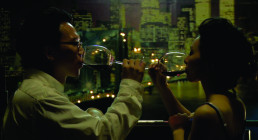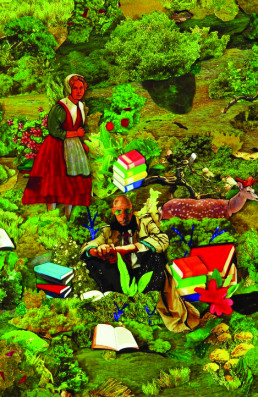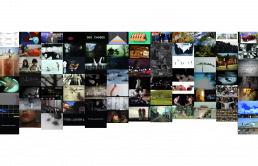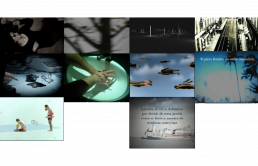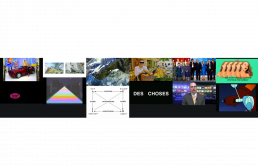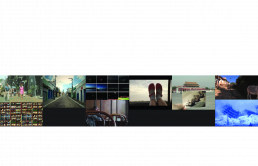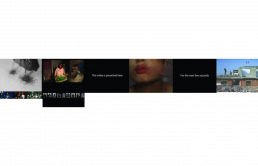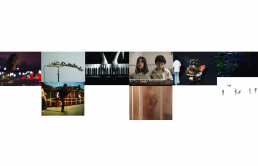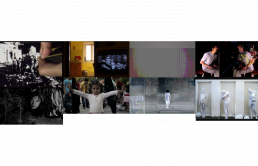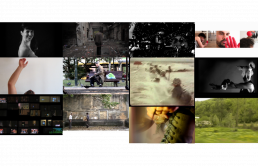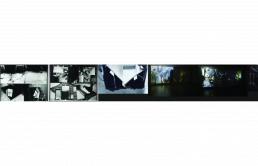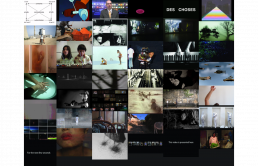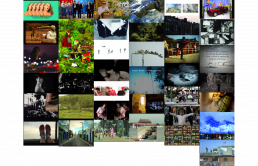“FUSO 2012 – 21 Agosto a 7 Setembro“
Programação
24 Agosto, 22h
Museu Nacional de Arte Contemporânea (MNAC) – Museu do Chiado
Katia Kameli
Curadoria de Jean-François Chougnet
Futur
O vídeo que Jean-François Chougnet irá apresentar, uma estreia mundial no FUSO, é o resultado de um novo processo de trabalho da artista franco-argelina Katia Kameli da sua residência na Futur Télécom, como parte dos «Ateliers de l’Euroméditerranée» de Marseille Provence 2013, Capital Europeia da Cultura. Neste trabalho, a artista toma como ponto de partida os funcionários da empresa Futur Télécom, criando um bypass da própria cidade de Marselha, através da realização de entrevistas a estes.
As mitologias íntimas e relacionais dos funcionários da Futur Télécom e a sua relação com Marselha tornam-se sinopses abertas, criando um trabalho baseado no princípio das matrioskas.
Katia Kameli é uma artista franco-argelina nascida em 1973 em Clermont-Ferrand, vive atualmente em Paris. O seu trabalho é inseparável da sua própria experiência, da sua identidade plural. De documentários a instalações de vídeo, fotografia e som, ela tenta destruir os limites entre o cinema e as artes visuais. A sua pesquisa explora um “entre-deux”, através do qual a adesão é rejeitada em favor da multiplicidade. O posicionamento do artista é um espaço que possibilita o surgimento de visões, posições e formas alternativas. O trabalho de Katia Kameli é reconhecido internacionalmente na Manifesta 8 (Murcia), no Centre Georges Pompidou, na Cinemateca Francesa e na Location One (Nova York), entre outros.
Apoio à programação Marseille-Provence 2013, Capital Europeia da Cultura
23h30
Fronteiras em Movimento: Um diálogo intercultural
Curadoria de Dalia Levin
Apoio à programação Herzliya Museum of Contemporary Art, Israel
O programa Fronteiras em Movimento: Um Diálogo Intercultural, apresentado pela curadora Dalia Levin, é um extrato da exposição em exibição no Museu de Arte Contemporânea de Herzliya, em Israel, apresentando o trabalho de artistas taiwaneses e israelitas num diálogo entre eles. Examinam essas fronteiras “em movimento” na vida quotidiana no contexto das questões sociais, políticas e económicas enfrentadas hoje por Taiwan, Israel e o Médio Oriente; abordando questões complexas relacionadas com a identidade individual, fronteiras territoriais, sociedade, economia e imigração nesta era de avançada tecnologia e globalização.
O conceito contextual mais óbvio da fronteira está ligado àquele do estado-nação. Frequentemente associado ao território ou à fronteira de um país, os limites mudaram significativamente ao longo da história. As fronteiras sociais e culturais estão em toda a parte na vida quotidiana e também constantemente sujeitas a mudanças. As fronteiras nacionais, os comportamentos pessoais, a estrutura das fortificações, a divisão celular a nível molecular, a demarcação dos campos académicos, as definições das palavras e os conceitos filosóficos são redefinidos de forma contínua e variada. Os limites estão sempre em movimento através de combinações de ação real e mudanças de consciência.
Mover limites implica uma infinidade de metáforas. Por meio de um diálogo intenso e ativo – que nos aproxima mais de uma perspetiva ou de uma proximidade de vez em quando -, tentamos atravessar vários limites e revertê-los para dentro e para fora. Com o tempo, as pessoas atravessam fronteiras consideráveis, novas e de todos os tipos, enquanto outras fronteiras são continuamente produzidas. A cada momento, uma parte da nossa consciência passa pelo ciclo de morte e renascimento; dissolvendo, cruzando e reorganizando inúmeros limites durante o processo. Os limites implicam definição e demarcação; a sua fluidez permite novos entendimentos e relações entre o soberano e o sujeito, sempre num ciclo de mudança.
Para o festival FUSO, a curadora Dalia Levin selecionou cinco vídeos de artistas taiwaneses.
Tsui Kuang-Yu, Invisible City: Taipari York, 2008, 5’03’’
Desde os anos 90 que Tsui Kuang-Yu realiza vídeos documentais de si próprio a representar em espaços particulares, que consistem nas suas subjetivas reflexões e perspetivas sobre uma determinada cidade. Estes pequenos filmes questionam os estereótipos que resultam e se imiscuem entre as pessoas, os espaços e as comunidades onde vivem, expondo uma cidade invisível.
Invisible City: Taipari York destaca o significante da cultura estrangeira existentes em Taiwan como a estátua da Liberdade, o Arco do Triunfo, a Torre Eiffel e a Ponte de Brooklyn. O humor do artista encoraja os espectadores de todas as idades a questionar porque foram construídos recentemente todos estes monumentos em Taiwan. “Tento expor verdades invisíveis que existem no dia a dia” diz o artista. Quando a perspetiva da câmara gradualmente se expande, de uma cena inicial, focada e enquadrada qual cartão postal ilustrado, para um tumultuoso plano aberto de uma rua em Taiwan, a ironia visual provoca uma gargalhada. O título do trabalho também reflete esta confusa realidade, levantando questões sobre as influências culturais entre o ocidente e o oriente.
Tu Pei-Shih, The Adventures in Mount Yu V, 2011, 6’30’’
As animações de Tu Pei-Shih abordam questões políticas, sociais e económicas. Em The Adventures in Mount Yu V (From Michel Foucault to Our Glorious Future), Tu Pei-Shih transforma as agradáveis e ingénuas ilustrações dos tradicionais livros escolares de Taiwan numa parcial e ficcionada história cultural do País. Assim o filme revela a própria natureza, da história dominante que foi fabricada e fragmentada. Neste trabalho o Monte Yu (o monte mais alto de Taiwan) é utilizado como cenário e identidade do povo de Taiwan. O filme começa com o filósofo francês Michel Foucault perdido nos seus pensamentos, num campo relvado, saltando rapidamente para imagens habitantes retirados da história colonial de Taiwan, incluindo nativos, holandeses, espanhóis, o líder militar Koxinga da dinastia Qing, japoneses, Chiang Kai-Shek e Kuomintang, entre outros. O vídeo termina relatando o Incidente 228, uma situação de grande escala de supressão política, muito conhecida do povo de Taiwan, mas que não estava, anteriormente, incluído nos manuais escolares publicados pelo National Institute for Compilation and Translations.
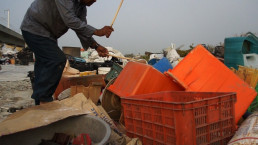
Su Yu-Hsien, Sounds of Nothing – Plastic Man, 2011, 6’45’’
O vídeo Plastic Man faz parte de uma trilogia intitulada Sounds of Nothing. Nesta série, Su Yu-Hsien, que cresceu numa zona remota do país, representa práticas sonoras amadoras, promovendo aqueles que não têm voz ativa, através da sua editora de música independente “indi-indi”. Refletindo o aumento da cena musical independente de Taiwan desde o final dos anos 90, bem como a atual popularidade do amadorismo em domínios globalizados. Os músicos e intérpretes da “indi-indi”, não são músicos profissionais, nem tiveram educação musical, tendo expectativas diferentes dos músicos convencionais. São trabalhadores que reciclam plástico. Não têm ideias predefinidas de que música ou som deverão produzir e assim, encarnam a liberdade do público em geral. De acordo com Su Yu-Hsien, “impotência” é a linguagem artística de quem, por norma, não é tido em consideração (um “zé ninguém”) e que raramente são ouvidos no discurso cultural: “Após duas ou três horas a ouvir a nossa banda a atuar, é clara a falta de modelos para a avaliação, porém a sua harmonia dispersa, sem melodia e ritmo, era no entanto fresca e pura. E acima de tudo, a inexplicável sensação de felicidade que este som produz surge da alegria positiva de ser impotente. Este tipo de alegria é passageira, porque não podemos imaginar a manutenção de uma banda que teme melhorar. Também me ocorreu que este tipo de som é o equivalente no universo à não existência (a razão para a não existência é que a sua universalidade é construída no facto de todos sermos “Zés ninguém” sem sermos representados), criando assim uma oportunidade de fazer a diferença por nos apresentarmos a nós mesmos.

Yao Jui-Chung, The Phantom of History, 2007, 2’28’’
Trata-se de um vídeo documentário representando o artista a marchar em torno do parque de esculturas de Cihu em Taoyuan. O ambiente em seu redor – uma vasta coleção de estátuas de Chiang Kai-Shek – e a ridícula marcha são tão irónicos como o seu isolamento físico e a incongruência da história. Quando Chiang Kai-Shek faleceu em 1975, foram erigidas cerca de 50.000 estátuas em sua memória e colocadas em escolas primárias, liceus, universidades, instituições governamentais, infraestruturas públicas e instalações militares. Após a lei marcial ter sido abolida em 1987, muitas foram desfiguradas e destruídas. O município Daxi em Cihu recolheu mais de cem estátuas que armazenou em Daxi Park, local do mausoléu de Chiang Kai-Shek. O comportamento de Yao à semelhança de Chiang personifica uma estátua viva – o comportamento do artista ressalta o absurdo desse contexto.

Wu Chi-Tsung, Landscape in the Mist 001, 2012, 9’15’’
Os trabalhos de vídeo de Wu Chi-Tsung centram-se nas questões da imagem e do espectador. As suas obras recentes usam pinturas tradicionais do Oriente para explorar como a cultura tradicional se relaciona com a contemporaneidade, abordando também a influência estrangeira. Landscape in the Mist 001 combina o estilo de Souvenir of Mortefontaine do pintor do sec. XIX, Jean-Baptiste-Camille Corot com imagens que incorporam o encanto da pintura de paisagem chinesa.
O trabalho enfatiza o papel da memória no processo de criação – quer das suas próprias raízes e experiências pessoais, bem como das da cultura tradicional ou dominante. O artista explora o exotismo de pinturas do Oriente, apelando a outros olhares, cultivando, assim, uma experiência estética multicultural.
“FUSO 2012 – August 21 to September 7“
Program
August 24, 10pm
Museu Nacional de Arte Contemporânea (MNAC) – Museu do Chiado
Katia Kameli
Curatorship by Jean-François Chougnet
Futur
The video which Jean-François Chougnet will present, a world premiere at FUSO, is the result of a new work process from the French-Algerian artist Katia Kameli from her residence at Futur Télécom, as part of the «Ateliers de l’Euroméditerranée» of Marseille Provence 2013, European Capital of Culture. In this work the artist takes as a starting point and guideline the employees of the Futur Télécom company, to create a way to a Marseille’s bypass, through interviews with employees.
The intimate and relational mythologies of the Futur Télécom employees and their relationship with Marseille become open synopses, creating a work based upon the principle of matrioskas.
Katia Kameli is a French-Algerian artist born in 1973 in Clermont-Ferrand, currently living in Paris. Her work is inseparable from her own experience, her plural identity. From documentaries to video installations, photography and sound, she attempts to change the boundaries between cinema and visual arts. Her research explores an “entre-deux”, through which the membership is rejected in favor of multiplicity. The positioning of the artist is a space that makes possible the emergence of alternative views, positions, shapes. Katia Kameli’s work is internationally recognized at Manifesta 8 (Murcia), at Centre Georges Pompidou, at French Cinematheque and at Location One (New York), among others.
Programming support Marseille-Provence 2013, European Capital of Culture
11:30pm
Boundaries on the Move: A Cross-Cultural Dialogue
Curatorship by Dalia Levin
Programming support Herzliya Museum of Contemporary Art, Israel
The program Boundaries on the Move: A Cross-Cultural Dialogue presented by the curator Dalia Levin is an extract of the exhibition actually being shown at the Herzliya Museum of Contemporary Art, Israel, featuring the work of Taiwanese and Israeli artists in a dialogue with one another. They examine those boundaries “on the move” in everyday life in the context of the social, political and economic issues facing Taiwan, Israel and the Middle East today; addressing complex issues of individual identity, territorial borders, society, economics and immigration in this age of advanced technology and globalization.
The most obvious contextual concept of the boundary is linked to that of the nation-state. Often associated with the territory or border of a country, boundaries have changed significantly over the course of human history. Social and cultural boundaries are everywhere in daily life and also constantly subject to change. National borders, personal behaviours, the structure of fortifications, molecular-level cellular division, the demarcation of academic fields, the definitions of words and philosophical concepts are all continually and variously redefined. Boundaries are always moving via combinations of real action and shifts in consciousness.
To move boundaries implies a multitude of metaphors. Through intense and active dialogue – which brings us closer in perspective or proximity now and again – we attempt to cross various boundaries, and to reverse them inside and out. Over time, people traverse considerable boundaries of all types and new, other boundaries are continually produced. Every moment, a part of our consciousness goes through the cycle of death and rebirth; blurring, dissolving, crossing and reorganizing countless boundaries in the process. Boundaries imply definition and demarcation; their fluidity allows for new understandings and relations between sovereign and subject, ever in a cycle of change.
For FUSO festival, the curator Dalia Levin selected five videos by Taiwanese artists.
Tsui Kuang-Yu, Invisible City: Taipari York, 2008, 5’03’’
Since the 1990s, Tsui Kuang-Yu has made documentary videos of himself performing in particular environments, which typically consist of the artist’s subjective reflections and perspective on a certain city. These short films question the stereotypes that derive from and pass between people and the places and communities where they live, to expose an invisible city.
Tsui’s Invisible City: Taipari York highlights the signifiers of foreign cultural that are distributed throughout Taiwan including the Statue of Liberty, Arc de Triomphe, La Tour Eiffel and the Brooklyn Bridge. The artist’s humorous vignette encourages viewers of all ages to consider why these monuments have been built recently in Taiwan. He has said: “I try to expose invisible truths that exist in daily life.” When the camera’s perspective gradually expands beyond an initially focused and tightly framed postcard-like scene to a tumultuous, wide-angle view of a street location in Taiwan, the visual irony causes one to chuckle. The work’s title also reflects the confused situation, raising questions regarding cultural influences between east and west.
Tu Pei-Shih, The Adventures in Mount Yu V, 2011, 6’30’’
Tu Pei-Shih’s animations treat contemporary political, economic and social issues. The Adventures in Mount Yu V (From Michel Foucault to Our Glorious Future) transforms the pleasantly naive illustrations found in traditional Taiwanese school textbooks into a partly fictitious colonial history of Taiwan. In this way, the film reveals the very nature of dominant, mainstream history as fabricated and fragmented. In this work, Taiwan’s tallest peak, Mt. Yu (3,952 m) serves both as background and symbol of Taiwanese identity. The Adventures in Mount Yu opens with the French philosopher Michel Foucault lost in thought on a grassy field, quickly skipping to images of inhabitants drawn from Taiwanese colonial history including Taiwan natives, the Dutch and Spanish, the Qing Dynasty’s military leader Koxinga, the Japanese, Chiang Kai-Shek and the Kuomintang, among others. The video ends after recounting the 228 Incident, an event of large-scale political suppression familiar to the people of Taiwan but not included in the official textbooks published by the National Institute for Compilation and Translations previously.

Su Yu-Hsien, Sounds of Nothing – Plastic Man, 2011, 6’45’’
The video Plastic Man is a part of a trilogy entitled Sound of Nothing. In this series, Su, who himself grew in a remote area of the country, represents amateur sound practices, promoting those without a voice, through his independent music label “indi-indi”. This echoes the rise of Taiwan’s independent music scene from the late 1990s onwards, as well as the current popularity of amateurism in globalized domains. The musicians and performers of “indi-indi” aren’t professional musicians nor have musical education and thus have different expectations than conventional musicians. They are workers who recycle plastics. Also, they have no predetermined ideas about what music or sound they should produce, and thus they embody the kind of freedom that the general public itself has. According to Su “powerlessness” is the artistic language of people who are not taken into account (“nobodies”) and they rarely heard in the cultural discourse: “After two or three hours of practice and listening to our band perform, it was clear we lacked any standards from which it could be judged, yet its scattered harmonies, which had no melody or rhythm to speak of, were nonetheless quite fresh and pure. More importantly, the inexplicable feeling of happiness that this sound produced arose from the positive joy of being powerless. This kind of joy is fleeting because we cannot imagine maintaining a band that dreads improvement. Also, it occurred to me that this kind of sound is equivalent to the universality of non-existence (the reason for non-existence is that its universality is built on the fact that we are all nobodies who are not represented), thus creating an opportunity to make a difference by presenting oneself.

Yao Jui-Chung, The Phantom of History, 2007, 2’28’’
Yao Jui-Chung’s Phantom of History is a video documentary depicting the artist goose-stepping around the Cihu Sculpture Park in Taoyuan. Yao’s surrounding environment – a vast collection of Chiang Kai-Shek statues – and ridiculous stride are as ironical as his physical isolation and the incongruity of history. When Chiang Kai-Shek passed away in 1975, approximately 50,000 statues of his likeness were erected at elementary schools, high schools, universities, government institutions, public infrastructures and military facilities in his honor. After martial law was abolished in 1987, many were defaced and thrown away. The Daxi township in Cihu collected over one hundred discarded statues and stored them in Daxi Park, the site of Chiang Kai-Shek’s mausoleum. Yao’s demeanor and resemblance to Chiang personify a statue come to life; the artist’s behavior underscoring the greater absurdity of his context.

Wu Chi-Tsung, Landscape in the Mist 001, 2012, 9’15’’
Wu Chi-Tsung’s video works focus on issues of imagery and spectatorship. Recently Wu used Eastern ink painting to explore how traditional culture relates to contemporary times, in addition to touching upon themes of foreignness. Landscape in the Mist 001 was produced specifically for this exhibition. It combines the style of Jean-Baptiste-Camille Corot’s nineteenth-century painting Souvenir of Mortefontaine with images embodying the charm of Chinese landscape painting.
The work emphasizes the role of recollection in the process of creation – that of one’s roots and personal experiences as well as those of traditional or dominant culture. The artist exploits the exoticism of Eastern ink paintings, which appeal to people all around the world, thus cultivating a cross-cultural aesthetic experience.

